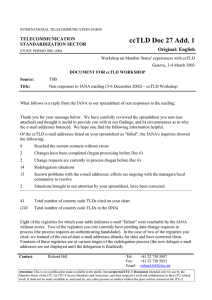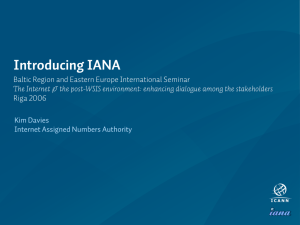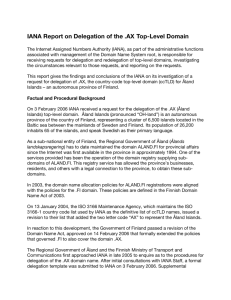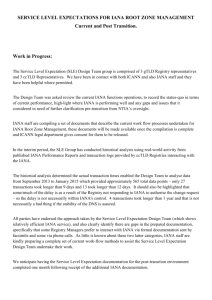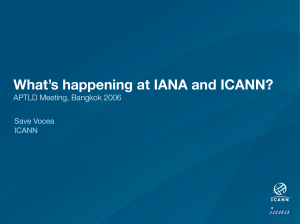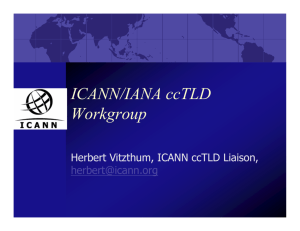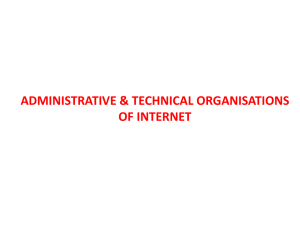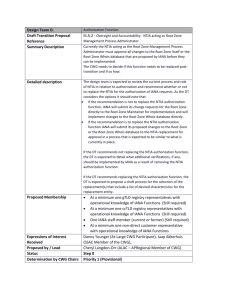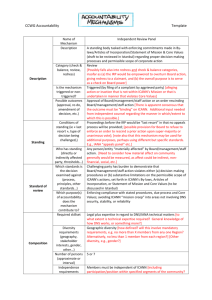Root Zone Changes and Redelegations
advertisement
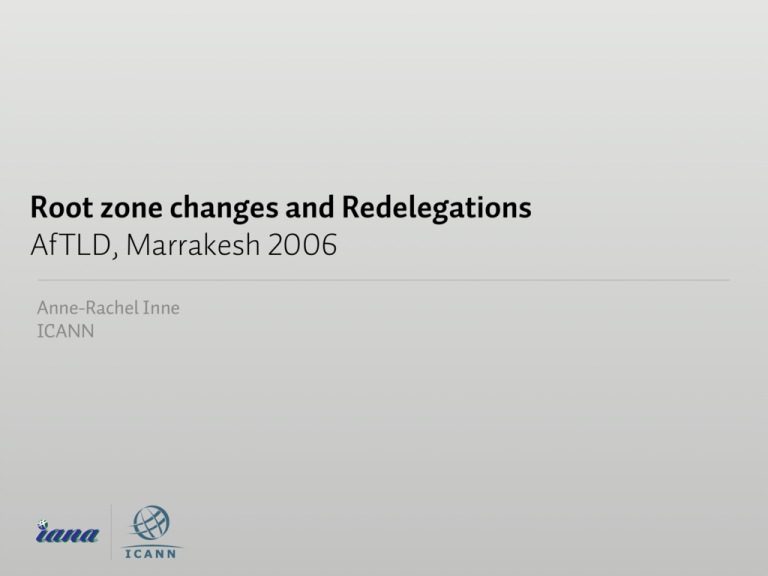
Root zone changes and Redelegations AfTLD, Marrakesh 2006 LOGOORIGINALPDF0- Anne-Rachel Inne ICANN root .nz .au .de .org .com.au fussball.de ibm.de The DNS Tree isoc.org news.com.au As we know, the DNS relies on delegating sub-domain responsibility down IANA root Intern etNZ .nz DENIC .au .de .org fussball.de FIFA ibm.de IBM The DNS Tree PIR auDA .com.au auDA isoc.org ISOC news.com.au New s Co rp Each zone has a party responsible for it, and for making delegations under it IANA root Intern e tNZ .nz DENIC .au .de .org fussball.de FIFA ibm.de IBM The DNS Tree PIR auDA .com.au auDA isoc.org ISOC news.com.au New s Co rp As operator of the root, IANA is responsible for assigning operators of top-level domains How we manage the root ‣ Maintain data for the DNS root ‣ Technical data (NS records, “glue”) ‣ Social data (admin and tech contacts, support organisations, WHOIS, Registration URL) ‣ Two types of changes 1. Routine changes (easy!) ‣ Confirm authenticity, check for technical problems, implement. 2. Redelegations (hard!) ‣ Perform evaluation, submit to ICANN board, implement as appropriate. Documents that guide us ‣ Domain Name Structure and Delegation (1994) ‣ http://www.rfc-editor.org/rfc/rfc1591.txt ‣ Domain Name Structure and Delegation (1999) ‣ http://www.icann.org/icp/icp1.htm ‣ The Governmental Advisory Committee Principles for Delegation and Administration of ccTLDs. ‣ http://www.icann.org/committees/gac/gaccctldprinciples-23feb00.htm What we don’t do ‣ Don’t set policy ‣ We follow precedent where possible, encourage review of our operations by community. ‣ Don’t decide what the two letter codes should be ‣ ISO 3166 standard provides these, ISO 3166 Maintenance Agency makes revisions ‣ Additions may be applied for by appropriate parties, deletions should be replaced. ‣ e.g. .zr became .cd, .cs became .cz & .sk. .tp to be .tl, .su split up. .yu to be ? ‣ Don’t decide who runs a ccTLD ‣ That’s for a local Internet community to decide! We just perform due diligence checks when it changes. Processing changes to the DNS Root IANA Processing Steps 1. For all changes: ‣ Check template is filled out correctly ‣ Check the current contacts agree to the change 2. For supporting organisation (SO) changes: ‣ Perform a redelegation evaluation 3. For contact (AC and/or TC) changes ‣ Check the new contacts respond and agree 4. For nameservers (NS) changes: ‣ Check nameservers work 5. For all changes: ‣ Seek US Government approval ‣ Implement in the DNS root with VeriSign ‣ Update our database Initial Processing for all requests ‣ Does the existing administrative contact and technical contact agree? ‣ Usually, if they don’t, it is a contested change and therefore becomes a redelegation ‣ Some exceptions if they just don’t answer, or staff have changed and old staff unreachable. ‣ In these cases, official representative of the SO should write to us requesting changes SO Changes ‣ Supporting Organisation is the ultimate authority for the domain. ‣ Changes to this usually mean completely changing the operator, called a “redelegation” ‣ Only exception is if the current SO has renamed or restructured ‣ government department shakeup ‣ company is bought by another company ‣ staff stay the same ‣ We’ll explain what a redelegation involves later, as they are complicated. AC & TC changes ‣ We check that the new AC and new TC agree, if appropriate ‣ Ask them if they will be responsible to operate the domain in the public interest. ‣ Check their email addresses work correctly! Nameserver changes ‣ We check the new list of nameservers 1. Do you have at least 2? 2. Can we reach them? 3. Do they answer authoritatively? (aa bit set) 4. Do they match your NS records? 5. Do they all provide the same answers? 6. Does the IP address specified as glue match the IP addresses in the A/ AAAA records? 7. Are you changing servers used by other TLDs? 8. Do your serial numbers match? 9. Are your nameservers on two or more networks? 10.Are you not changing every nameserver all at once? Final processing ‣ Once we have checked and tested all these steps: ‣ Sent to US Department of Commerce for approval ‣ They review all root zone requests to make sure we followed policy. ‣ Sent to VeriSign to update the zone ‣ The run the “A” root server, essentially the primary for the root. ‣ Finally, we update our database ‣ New details seen on whois.iana.org, IANA website, etc. More about redelegations Redelegations ‣ Most changes to our database are routine updates ‣ e.g. operator has updated their nameserver list, changed addresses, or added a new staff member ‣ Some changes involve changing the ccTLD management to a new party ‣ We need to do a thorough investigation this operator will operate the domain in the interests of the country ‣ We call this a “redelegation” Some quotes on redelegation ‣ “selecting a designated manager for a domain that was able to do an equitable, just, honest and competent job” ‣ “These designated authorities are trustees for the delegated domain, and have a duty to serve the community. The designated manager is the trustee of the top-level domain for both the nation and the global Internet community” Redelegation Agreement ‣ Generally, to redelegate a domain, the change needs to be approved by: ‣ the current/old operator ‣ the relevant government ‣ substantial parties in the local Internet community ‣ In cases where the current operator is doing a bad job, and everyone else agrees, we will conduct a “hostile redelegation”. ‣ Government’s view is important - but is not the only view. If government asks for a change, but significant parties disagree, it can’t be assumed we will redelegate. Redelegation Difficulties ‣ Some local disagreements: ‣ Between old and new managers ‣ Between government and old manager ‣ Between local Internet community and government ‣ between old manager and local Internet community ‣ between different government departments ‣ IANA always has to be careful of fraud - many parties want to try and take over something valuable like a ccTLD! Redelegation Difficulties (2) ‣ Misunderstandings ‣ Requests by unauthorised staff ‣ Requests without understanding of procedures ‣ Technical problems ‣ ‣ ‣ ‣ ‣ ‣ Technical ability of new manager and/or his staff Problems with technical systems Absence of any local policies Absence of a business/commercial model Problems with hosting arrangements or physical premises Disagreement with the ISO alpha-2 designation Redelegation Difficulties (3) ‣ Political Problems ‣ Goverments lacking a legal/policy basis for closing down an organisation. ‣ Governments seeking political control over the ccTLD / seeking change for political reasons ‣ Disagreements between operator and government, or between government departments ‣ Legacy Problems ‣ ccTLD operations out of country ‣ Compensation claims of old managers ‣ Governments suddenly claiming back a “national asset” Complex situations and issues ‣ Out-of-country ccTLD operation under a contested redelegation request ‣ Verification of identity and authority of involved persons ‣ Contested redelegation requests (no local agreement), particular in cases where there is no legislation/regulation, relies on good will of parties Redelegations: Evaluation Process ‣ IANA performs a thorough evaluation in redelegations ‣ Speaks to many affected parties ‣ Evaluates the change on a number of criteria ‣ Writes a detailed report recommending a course of action ‣ ICANN Board votes on the report ‣ If they approve to redelegate, is processed like a regular change. ‣ If they don’t, we reject the change. Applicant may reapply if they change the circumstances. Criteria for Redelegation 1. Operational and technical skills a. The prospective manager has the requisite skills to operate the TLD appropriately. (ICP-1 §a, RFC 1591 §3.5) b. There must be reliable, full-time IP connectivity to the nameservers and electronic mail connectivity to the operators; (ICP-1 §a; RFC 1591 §3.1) c. The manager must perform its duties in assigning domains and operating nameservers with technical competence (ICP-1 §d; RFC 1591 §3.5) 2. Operator in country a. The prospective manager supervises and operates the domain name from within the country represented by the TLD; (ICP-1 §a; RFC 1591 §3.1) b. The prospective administrative contact must reside in the country represented by the TLD. (ICP-1 §a; RFC 1591 §3.1) 3. Equitable treatment a. The prospective manager must be equitable and fair to all groups encompassed by the TLD that may request domain names (ICP-1 §c; RFC 1591 §3.3) 4. Community/Governmental support a. The prospective manager has the requisite authority to operate the TLD appropriately, with the desire of the government taken very seriously. (ICP-1 §a, GAC Principles) b. Significantly interested parties in the domain should agree that the prospective manager is the appropriate party to receive the delegation (ICP-1 §a; RFC 1591 §3.4) What should you do? Get your data in order ‣ IANA keeps records on who runs each TLD ‣ If it is out of date, we don’t know who is responsible any more ‣ Causes problems if changes need to be made later ‣ Also causes problems if someone needs to contact you for operational reasons. ‣ Check your IANA records and update if necessary! How? Check your data 1) Go to http://whois.iana.org in your web browser. 2) Type in your TLD 3) Check the data is up to date I need to make changes! What now? Lodge a change template ‣ We have a simple text template for you to complete and email to us. ‣ Download it from ‣ http://www.iana.org/cctld/cctld-template.txt Instructions on changing details ‣ Download the template file ‣ Fill in your updated details ‣ For sections that don’t change, you can simply write “No Change” rather than filling in all the current details again. ‣ Make sure everyone at your end is aware of the upcoming change! ‣ Admin and Tech contact need to approve it! ‣ Email to root-mgmt@iana.org ‣ Let’s step through the form... Summary Summary ‣ IANA manages the root, and therefore the delegations that allow TLDs to do their work. ‣ TLDs should ensure their data (contact details, nameserves) are accurate with IANA. If in doubt, talk with us! ‣ IANA’s procedures to verify changes are thorough, to ensure stability of the DNS root. ‣ Full changes to the operator involve an investigation to ensure the changes are in the interest of the local community. LOGOORIGINALPDF0- Thankyou for your attention! Kim Davies kim.davies@icann.org
